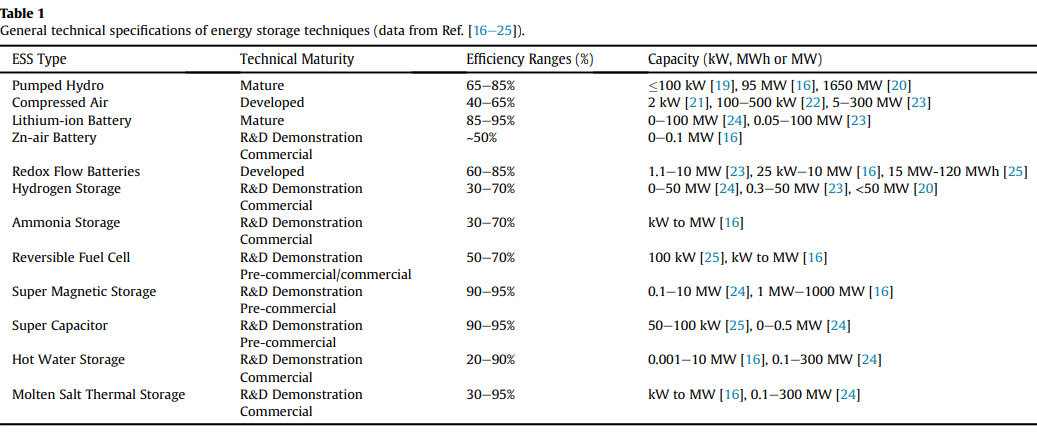...how energy is stored, the act of storing it wastes it. If the stored energy comes from fossil fuels - and let's stop lying to ourselves, roughly 80% of the world energy supply comes from this source - it means that one must burn more fossil fuels than one would do without storing energy. Energy that is put to use, which is always less energy than released in the use of a primary energy source, is called "exergy." Storing energy makes less energy available for use, and thus it destroys exergy.
There's a nice paper covering the whole topic here, giving the thermodynamic efficiency of various forms of energy storage, twelve of them, in fact: Manal AlShafi, Yusuf Bicer, Thermodynamic performance comparison of various energy storage systems from source-to-electricity for renewable energy resources, Energy, Volume 219, 2021, 119626.
The paper refers to the useless concept of so called "renewable energy" in the title, but applies to all forms of energy. The purpose of the useless so called "renewable energy" scheme is to convince a gullible public that energy storage is a good idea, and thus create an increased market for dangerous fossil fuels. The Moss Landing Plant is a dangerous natural gas plant, not a magical so called "renewable energy" plant. When the electricity generated in the plant is used to charge batteries, energy is wasted. Were it applied to the grid directly, without storage, more electricity would be available to provide exergy. Thus to charge the batteries, more natural gas is burned than would otherwise be burned.
Before the energy storage scam became popular because people believed that so called "renewable energy" was both significant and sustainable - it is neither - reliability was managed by running a few extra power plants than needed for immediate demand, to address demand surges. This was called "spinning reserve."
The forms of energy storage described in the paper, which looks pretty damned comprehensive to me, even if it doesn't cover flywheels, where the energy losses are frictional, both mechanical and air based, are shown in the following graphic:

There's a nice table of the ranges of energy losses via storage:

Ranges are given because a thermodynamic system depends sensitively on design, and more importantly, operating conditions, the most important of which is temperature.
Each storage system discussed in the paper has a nice schematic graphic associated with it. Here's the one for the most contemptibly marketed form of energy storage to my mind, one that is almost exclusively dependent on the waste of fossil fuels, hydrogen:

In the graphic, "heat out" represents destroyed exergy.
Here's some text describing the energy losses when the hydrogen is stored and when it is used; there are additional energy losses when hydrogen is produced, which are not discussed here:
2.5. Hydrogen storage
The hydrogen storage system includes a hydrogen storage tank, hydrogen fuel cell, cooler unit, and compressor. The primary input of this system is chemical energy. The main flows of the system are hydrogen and air, with two main outputs, as shown in Fig. 7. The chemical energy is stored in the hydrogen storage, and it leaves as gaseous hydrogen, entering the hydrogen fuel cell. As the air leaves the compressor, it enters the cooler unit to decrease the air temperature, and it enters the hydrogen fuel cell. The reaction of both air and gaseous hydrogen in the fuel cell produces the electrical output along with nitrogen and water.
The hydrogen storage system state point properties are shown in Table 10, and the following assumptions are considered for calculations:
•
The mass flow rate is calculated by considering 98 kg stored in the hydrogen storage tank (24 h operation considered)
•
The hydrogen fuel cell has a 30% heat loss.
•
The isentropic efficiency of the compressor is 85%
•
7.5% mass loss is assumed for hydrogen storage tank
I hope this helps explain why the popular fantasies about energy storage are pernicious in the extreme.
Enjoy the rest of the weekend as best as you can under the circumstances.
 = new reply since forum marked as read
= new reply since forum marked as read


